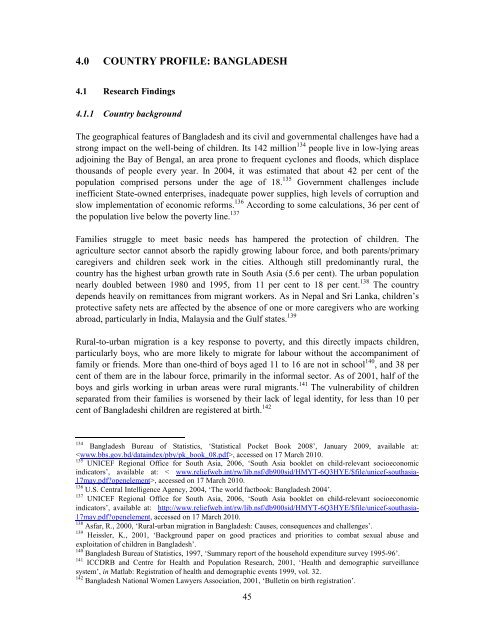SEXUAL ABUSE AND EXPLOITATION OF BOYS IN SOUTH ASIA A ...
SEXUAL ABUSE AND EXPLOITATION OF BOYS IN SOUTH ASIA A ...
SEXUAL ABUSE AND EXPLOITATION OF BOYS IN SOUTH ASIA A ...
You also want an ePaper? Increase the reach of your titles
YUMPU automatically turns print PDFs into web optimized ePapers that Google loves.
4.0 COUNTRY PR<strong>OF</strong>ILE: BANGLADESH<br />
4.1 Research Findings<br />
4.1.1 Country background<br />
The geographical features of Bangladesh and its civil and governmental challenges have had a<br />
strong impact on the well-being of children. Its 142 million 134 people live in low-lying areas<br />
adjoining the Bay of Bengal, an area prone to frequent cyclones and floods, which displace<br />
thousands of people every year. In 2004, it was estimated that about 42 per cent of the<br />
population comprised persons under the age of 18. 135 Government challenges include<br />
inefficient State-owned enterprises, inadequate power supplies, high levels of corruption and<br />
slow implementation of economic reforms. 136 According to some calculations, 36 per cent of<br />
the population live below the poverty line. 137<br />
Families struggle to meet basic needs has hampered the protection of children. The<br />
agriculture sector cannot absorb the rapidly growing labour force, and both parents/primary<br />
caregivers and children seek work in the cities. Although still predominantly rural, the<br />
country has the highest urban growth rate in South Asia (5.6 per cent). The urban population<br />
nearly doubled between 1980 and 1995, from 11 per cent to 18 per cent. 138 The country<br />
depends heavily on remittances from migrant workers. As in Nepal and Sri Lanka, children’s<br />
protective safety nets are affected by the absence of one or more caregivers who are working<br />
abroad, particularly in India, Malaysia and the Gulf states. 139<br />
Rural-to-urban migration is a key response to poverty, and this directly impacts children,<br />
particularly boys, who are more likely to migrate for labour without the accompaniment of<br />
family or friends. More than one-third of boys aged 11 to 16 are not in school 140 , and 38 per<br />
cent of them are in the labour force, primarily in the informal sector. As of 2001, half of the<br />
boys and girls working in urban areas were rural migrants. 141 The vulnerability of children<br />
separated from their families is worsened by their lack of legal identity, for less than 10 per<br />
cent of Bangladeshi children are registered at birth. 142<br />
134<br />
Bangladesh Bureau of Statistics, ‘Statistical Pocket Book 2008’, January 2009, available at:<br />
, accessed on 17 March 2010.<br />
135<br />
UNICEF Regional Office for South Asia, 2006, ‘South Asia booklet on child-relevant socioeconomic<br />
indicators’, available at: < www.reliefweb.int/rw/lib.nsf/db900sid/HMYT-6Q3HYE/$file/unicef-southasia-<br />
17may.pdf?openelement>, accessed on 17 March 2010.<br />
136<br />
U.S. Central Intelligence Agency, 2004, ‘The world factbook: Bangladesh 2004’.<br />
137<br />
UNICEF Regional Office for South Asia, 2006, ‘South Asia booklet on child-relevant socioeconomic<br />
indicators’, available at: http://www.reliefweb.int/rw/lib.nsf/db900sid/HMYT-6Q3HYE/$file/unicef-southasia-<br />
17may.pdf?openelement, accessed on 17 March 2010.<br />
138<br />
Asfar, R., 2000, ‘Rural-urban migration in Bangladesh: Causes, consequences and challenges’.<br />
139<br />
Heissler, K., 2001, ‘Background paper on good practices and priorities to combat sexual abuse and<br />
exploitation of children in Bangladesh’.<br />
140<br />
Bangladesh Bureau of Statistics, 1997, ‘Summary report of the household expenditure survey 1995-96’.<br />
141<br />
ICCDRB and Centre for Health and Population Research, 2001, ‘Health and demographic surveillance<br />
system’, in Matlab: Registration of health and demographic events 1999, vol. 32.<br />
142<br />
Bangladesh National Women Lawyers Association, 2001, ‘Bulletin on birth registration’.<br />
45










